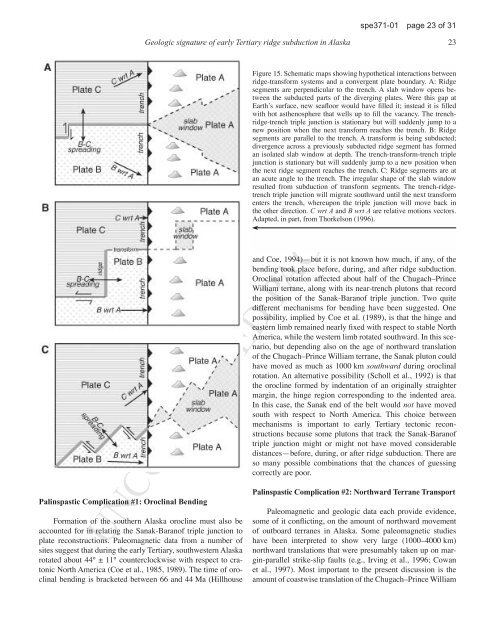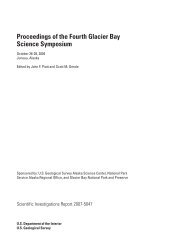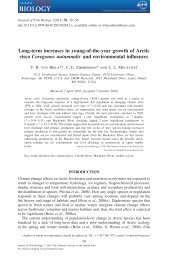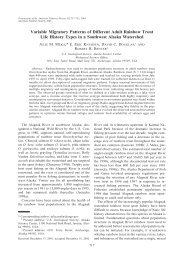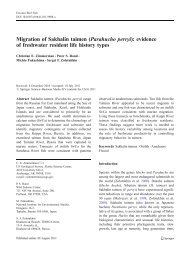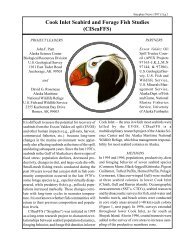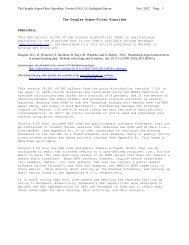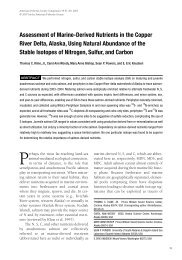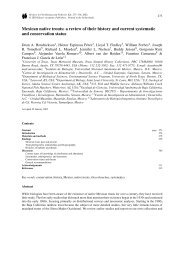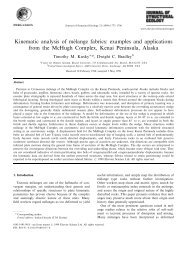UNCORRECTED PAGE PROOFS - USGS Alaska Science Center
UNCORRECTED PAGE PROOFS - USGS Alaska Science Center
UNCORRECTED PAGE PROOFS - USGS Alaska Science Center
You also want an ePaper? Increase the reach of your titles
YUMPU automatically turns print PDFs into web optimized ePapers that Google loves.
spe371-01 page 23 of 31<br />
Geologic signature of early Tertiary ridge subduction in <strong>Alaska</strong> 23<br />
Palinspastic Complication #1: Oroclinal Bending<br />
Formation of the southern <strong>Alaska</strong> orocline must also be<br />
accounted for in relating the Sanak-Baranof triple junction to<br />
plate reconstructions. Paleomagnetic data from a number of<br />
sites suggest that during the early Tertiary, southwestern <strong>Alaska</strong><br />
rotated about 44° ± 11° counterclockwise with respect to cratonic<br />
North America (Coe et al., 1985, 1989). The time of oroclinal<br />
bending is bracketed between 66 and 44 Ma (Hillhouse<br />
Figure 15. Schematic maps showing hypothetical interactions between<br />
ridge-transform systems and a convergent plate boundary. A: Ridge<br />
segments are perpendicular to the trench. A slab window opens between<br />
the subducted parts of the diverging plates. Were this gap at<br />
Earthʼs surface, new seaßoor would have Þlled it; instead it is Þlled<br />
with hot asthenosphere that wells up to Þll the vacancy. The trenchridge-trench<br />
triple junction is stationary but will suddenly jump to a<br />
new position when the next transform reaches the trench. B: Ridge<br />
segments are parallel to the trench. A transform is being subducted;<br />
divergence across a previously subducted ridge segment has formed<br />
an isolated slab window at depth. The trench-transform-trench triple<br />
junction is stationary but will suddenly jump to a new position when<br />
the next ridge segment reaches the trench. C: Ridge segments are at<br />
an acute angle to the trench. The irregular shape of the slab window<br />
resulted from subduction of transform segments. The trench-ridgetrench<br />
triple junction will migrate southward until the next transform<br />
enters the trench, whereupon the triple junction will move back in<br />
the other direction. C wrt A and B wrt A are relative motions vectors.<br />
Adapted, in part, from Thorkelson (1996).<br />
and Coe, 1994)—but it is not known how much, if any, of the<br />
bending took place before, during, and after ridge subduction.<br />
Oroclinal rotation affected about half of the Chugach–Prince<br />
William terrane, along with its near-trench plutons that record<br />
the position of the Sanak-Baranof triple junction. Two quite<br />
different mechanisms for bending have been suggested. One<br />
possibility, implied by Coe et al. (1989), is that the hinge and<br />
eastern limb remained nearly Þxed with respect to stable North<br />
America, while the western limb rotated southward. In this scenario,<br />
but depending also on the age of northward translation<br />
of the Chugach–Prince William terrane, the Sanak pluton could<br />
have moved as much as 1000 km southward during oroclinal<br />
rotation. An alternative possibility (Scholl et al., 1992) is that<br />
the orocline formed by indentation of an originally straighter<br />
margin, the hinge region corresponding to the indented area.<br />
In this case, the Sanak end of the belt would not have moved<br />
south with respect to North America. This choice between<br />
mechanisms is important to early Tertiary tectonic reconstructions<br />
because some plutons that track the Sanak-Baranof<br />
triple junction might or might not have moved considerable<br />
distances—before, during, or after ridge subduction. There are<br />
so many possible combinations that the chances of guessing<br />
correctly are poor.<br />
Palinspastic Complication #2: Northward Terrane Transport<br />
Paleomagnetic and geologic data each provide evidence,<br />
some of it conßicting, on the amount of northward movement<br />
of outboard terranes in <strong>Alaska</strong>. Some paleomagnetic studies<br />
have been interpreted to show very large (1000–4000 km)<br />
northward translations that were presumably taken up on margin-parallel<br />
strike-slip faults (e.g., Irving et al., 1996; Cowan<br />
et al., 1997). Most important to the present discussion is the<br />
amount of coastwise translation of the Chugach–Prince William<br />
<strong>UNCORRECTED</strong> <strong>PAGE</strong> <strong>PROOFS</strong>


